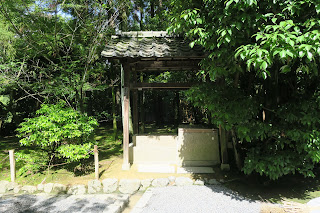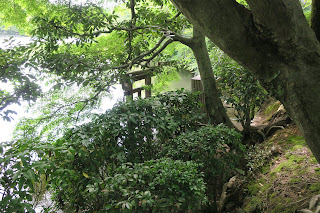Ryoan-ji (The Temple of the Dragon at Peace) is a Zen temple located in
northwest Kyoto, Japan.
It belongs to the Myoshin-ji school of the Rinzai branch of Zen Buddhism.
The Ryoan-ji garden is considered one of the finest surviving examples of "dry
landscape" (kare-sansui), a refined type of Japanese Zen temple garden
design generally featuring distinctive larger rock formations arranged amidst
a sweep of smooth pebbles (small, carefully selected polished river rocks)
raked into linear patterns that facilitate meditation.
|
Entering Ryoan-ji Temple.
|
|
Gate of the three liberations (Sanmom).
A sanmon, also called sangedatsumon (lit. "gate of the
three liberations"), is the most important gate of a Japanese Zen
Buddhist temple, and is part of the Zen shichido garan, the group
of buildings that forms the heart of a Zen Buddhist temple.
-
Most sanmon are 2- or 3-bay nijumon (a type of
two-storied gate), but the name by itself does not imply any specific
architecture.
-
See more at
Sanmon - Wikipedia.
|
|
Ryoan-ji Temple map.
he site of the temple was an estate of the Fujiwara clan in the 11th
century.
-
The first temple, the Daiju-in, and the still existing large pond were
built in that century by Fujiwara Saneyoshi.
-
In 1450, Hosokawa Katsumoto, another powerful warlord, acquired the
land where the temple stood. He built his residence there, and founded
a Zen temple, Ryōan-ji.
|
|
Pond seen from the southeast.
|
|
Benzaiten Temple.
The Benzaiten temple is located on a small island in the middle of the
pond. The vermilion torii gate can be seen through the trees.
-
Benzaiten (lit. "goddess of eloquence"), also simply known as Benten,
is a Japanese Buddhist goddess who originated mainly from Saraswati,
the Hindu goddess of speech, the arts, and learning, with certain
traits deriving from the warrior goddess Durga.
-
Benzaiten is a female kami to Shinto with the name
Ichikishima-hime-no-mikoto.
-
See more at
Benzaiten - Wikipedia.
|
|
Buddha statue among the trees.
|
|
Removing shoes.
A common place to take off your shoes is at shrines and temples. This
can be confusing as not every shrine or temple requires it, and it is
usually limited to within the main building.
-
However, most shrines and temples that do require you to remove your
shoes will have a clear area for doing so as well as racks or boxes to
store your shoes, and possibly signs to remind you to do so.
|
|
Dragon in clouds (Unryū-zu) mural in the Hojo.
The hojo is divided into six rooms by sliding doors called fusuma; three
rooms on the south (a reception, a lecture room and a meeting room) and
those on the north (a study, a changing room and a central room
consisting of three subdivisions of a serving chamber, alter, and
sleeping room).
-
The term "hojo" comes from "square" and "a measurement unit". The
basic size of "jo" is a little more that 3m, making a traditional hojo
a bit larger than 9 sqm. A thatched hut of this size was easy to build
and unbuilt and was used by hermits – so the story goes. Once, the
Bodhisattva Manjushri and his party visited the hojo of Vimalakirti.
Even though the space was so small, all fitted into it. From this time
on it was said the the whole universe fits into one hojo. This is also
the reason why the room of the head priest of a temple is called hojo.
|
|
Zen Garden panorama.
The temple's name is synonymous with the temple's famous Zen garden, the
dry landscape (karesansui) rock garden, thought to have been built in
the late 15th century.
-
The garden is a rectangle of 248 square meters (2,670 square feet),
twenty-five meters by ten meters.
-
Placed within it are fifteen stones of different sizes, carefully
composed in five groups; one group of five stones, two groups of
three, and two groups of two stones.
-
The stones are surrounded by white gravel, which is carefully raked
each day by the monks. The only vegetation in the garden is some moss
around the stones.
|
|
Zen Garden details.
The garden is meant to be viewed from a seated position on the veranda
of the hōjō, the residence of the abbot of the monastery.
-
The stones are placed so that the entire composition cannot be seen at
once from the veranda.
-
The wall behind the garden is an important element of the garden. It
is made of clay, which has been stained by age with subtle brown and
orange tones.
-
Like any work of art, the artistic garden of Ryoan-ji is also open to
interpretation or research into possible meanings. Many different
theories have been put forward inside and outside Japan about what the
garden is supposed to represent, from islands in a stream, a tiger
family crossing a river, mountain peaks, to theories about secrets of
geometry or the rules of equilibrium of odd numbers.
|
|
Tray landscape (Bonkei).
Right next to the rock garden, in front of the shop, there is a
miniature model that allows visually impaired people to appreciate the
rock garden. The model, which accurately reproduces the shape of the
rock garden, reproduces the undulating white sand and craggy rocks.
-
A bonkei (Japanese for "tray landscape") is a temporary or
permanent three-dimensional depiction of a landscape in miniature,
portrayed using mainly dry materials like rock, papier-mâché or cement
mixtures, and sand in a shallow tray.
-
A bonkei contains no living material, in contrast with related
Japanese art forms bonsai and saikei:
bonsai contain living trees, and saikei contain living
trees and other vegetation.
-
See more at
Bonkei - Wikipedia.
|
|
Stone water basin (Tsukubai).
Ryoan-ji also has a teahouse and tea garden, dating to the 17th century.
Near the teahouse is a famous stone water basin, with water continually
flowing for ritual purification.
-
This is the Ryoan-ji tsukubai, which translates as "crouch"; because
of the low height of the basin, the user must bend over to use it, in
a sign of reverence and humility.
-
The kanji written on the surface of the stone basin, are without
significance when read alone. Though the water basin's frame is
circular, the opening in the circular face is itself a square. If each
of the four kanji is read in combination with the square-shaped
radical is pronounced kuchi, meaning "mouth" or "aperture", which the
square opening is meant to represent. This is read as "I only
sufficiency know" or, more poetically, as "I know only satisfaction".
Intended to reinforce Buddhist teachings regarding humility and the
abundance within one's soul, the meaning is simple and clear: "one
already has all one needs".
-
Meanwhile, the positioning of the tsukubai, lower than the veranda on
which one stands to view it, compels one to bow respectfully (while
listening to the endless trickle of replenishing water from the bamboo
pipe) to fully appreciate its deeper philosophical significance.
-
The tsukubai also embodies a subtle form of Zen teaching using ironic
juxtaposition: while the shape mimics an ancient Chinese coin, the
sentiment is the opposite of materialism. Thus, over many centuries,
the tsukubai has also served as a humorous visual koan for countless
monks residing at the temple, gently reminding them daily of their vow
of poverty.
-
Notwithstanding the exquisite kare sansui rock garden on the opposite
side of the building, the less-photographed Ryoan-ji tea garden is
another cultural treasure of the temple.
|
|
Temple bell (Bonsho).
Rung by striking from outside as bell has no internal clapper.
|
|
Burmese Stupa.
This stupa was donated from Burma in memorial of all the people who had
died there during WW2.
|
|
Small torii gate on the shore of the pond.
|
|
Walking towards the exit.
|
See also
Source
Location
Kyoto Gion District
Zen Buddhism
Kinkaku-ji Temple
Teramachi Shopping Street
Japanese Tea Ceremony
Kodai-ji Temple
Ginkaku-ji Temple
Philosopher's Walk
Nijo Castle







































